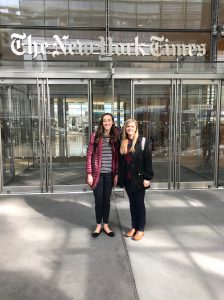
It was just past 8 a.m. when we emerged from the subway, and New York City was already bustling with the life and vibrancy of a “city that never sleeps.”
The city wasn’t the only thing that hadn’t slept that night.
Though fatigued from our red-eye flight, we felt invigorated by both the bustle of big-city life around us and the prospect of spending a day at The New York Times’ 2018 Student Newspaper Editors’ Workshop.
With our return flight around 8 p.m., 12 hours seemed hardly enough time to see more than Times Square, but we knew any time at The New York Times would be time well spent.
With entrances on three sides of the building, The New York Times is hard to miss. It’s located only a couple blocks away from Times Square, which we learned is actually named after the famous newspaper.
After checking in, we took an elevator up to the 15th floor, accompanied by a security guard who — if for nothing else than his unmistakable accent — seemed to embody the tough, slightly sardonic, matter-of-fact New Yorker stereotype.
Not able to leave the 15th floor, we explored where we could, admiring a spanning wall displaying all the Pulitzer prizes The New York Times has won over the years.
Looking out the windows, 15 floors up hardly seemed tall as the surrounding buildings sprawled higher and higher still.
The conference was for student editors at university and college newspaper publications around the country, and we spent the morning listening and learning from Times staff, including an investigative reporter, a senior editor and an internship director.
Nicholas Confessore, a political and investigative reporter for the Times, came in at the beginning for a couple of minutes before he was called away to meet with lawyers and editors, no doubt some kind of lawsuit looming in the foreground. It was exciting to see the life of a professional reporter in action.
Confessore’s passion for journalism was tangible, and we were all listening on the edge of our seat as he told us what precious few words he could before duty called him away again.
Memorably, he said a good story “is something somebody doesn’t want you to know.” He said a journalist’s right and responsibility is to examine and hold accountable powerful people and institutions (probably why he had a meeting with his lawyers and editor that day). This is the heart of journalism, Confessore said, and it is evident through his own journalistic impact that Confessore walks the walk.
Next, we workshopped a rough draft of a Times article with Senior Editor Mark Bulik, collaborating with other student editors on how to fix mistakes and improve organization. Bulik said it’s important to work with other editors to fix a story because there are things you can learn from one another.
The afternoon was spent in lectures from different Times media representatives on social media, audio, Snapchat and newsletters.
Each representative discussed their responsibilities and how they pertain to The New York Times and journalism. Each media category has a team that works hard to increase interaction with readers, viewers and subscribers.
Kenan Davis, assistant editor for graphics, discussed the in-depth process involved in covering breaking news from a graphics aspect.
Davis related the process of covering the Las Vegas shooting. He said he and his team received the news around 5 a.m., working late into the night to finish graphic and media elements for the breaking news stories as coverage developed.
Some of these elements included a map, a rendering of the shooter’s hotel room, an animation explaining bump stocks and floor plans showing key locations pertinent to the shooting.
The conference ended with remarks and a Q&A with publisher A.G. Sulzberger, a skinny, bespectacled man in his 30s. Sulzberger replaced his father as publisher for the Times on Jan. 1; his father had served as publisher since 1992.
Sulzberger discussed the importance of maintaining journalistic ethics and staying true to the Times’ brand of journalism: telling the truth.
Impressively, he said if they aren’t 100 percent sure something is true, The New York Times won’t run the story because they would rather be second to another newspaper than disappoint their readership with inaccuracies.
Another important element Sulzberger discussed was how journalism shines a light on the part of the world that people are ignoring. In essence, he said the Times’ purpose is to help people understand the world and empower them to make decisions.
As aspiring journalists ourselves, seeing so many other dedicated, hard-working students and professionals in the field gave us hope for journalism’s future. Not only that, but it motivated us to do the best work we can here at The Daily Universe and wherever we may end up some day.
As we were jostled about in the crowded subway that afternoon, surrounded by New Yorkers returning home after a long work day, we felt different. Enlightened and empowered, we rededicated ourselves to telling our readers’ stories — your stories — as best we can. Though it seemed to pass by in a whirlwind, our day at the New York Times was truly unforgettable.
We hope you as readers understand the importance of the work we do as we strive to bring quality journalism to campus. So, be informed, listen and let us help you get your stories heard.




